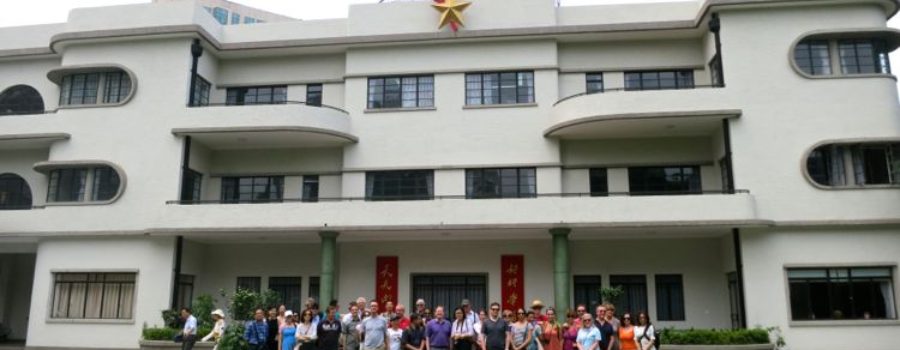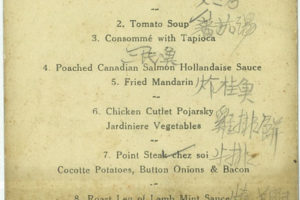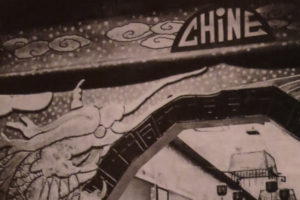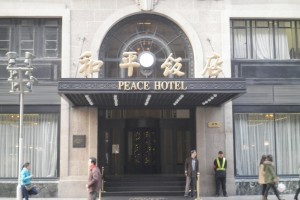Speedlines and secret gardens, buried opium and Moderne mansions overlaid with Communism; a street parade and even a silent protest: it was all part of the June 14 Historic Shanghai Art Deco Walking Tour. Pretty plane tree-shaded avenues, elegant architecture and vibrant street life always makes walking through Shanghai’s former French Concession a treat, but all the more so when the stories of these streets come alive.
Historic Shanghai president Wm Patrick Cranley led nearly 40 participants through the western part of the former French Concession, taking in Art Deco highlights and a century’s worth of history. In Shanghai, Art Deco comes wrapped in layers of history, from the Concession-era to the Cultural Revolution to the present day; some spoken, some mysterious.
We saw buildings from the three main Art Deco eras, and learned to identify Art Deco motifs – like the speedlines below. And we saw Shanghai’s history, all around us. Indeed, one of the first things we did – strangely, for a tour focused on buildings – was look down. There, at our feet, was a manhole cover marked “CMF 1939” – Conseil Municipal Francais, and the year it was installed. In Shanghai, history is all around us – even underfoot.
This walk took us through some of the Art Deco highlights of the former French Concession, beginning with the Amyron Apartments, built in 1941 by French architect Alexandre Leonard. He designed numerous beautiful buildings – many of which we’ll see today – but he chose to live in the Amyron, saving the two-storey penthouse for himself and his wife, Anna. In the lobby, his initials remain boldly in the terrazzo.
Leonard also built the former Rong Mansion in 1939, the onetime home of one of old Shanghai’s wealthiest men, Rong Desheng. Today, the proud logo of the Young Pioneers bursts from its roof: the former “Textile King’s” home is now a Children’s Palace – a place for after-school activities. If you look closely at the columns in front of the building, you can make out “Long Live Chairman Mao”, painted during the Cultural Revolution. (But the family cooperated with the new Communist government in 1949, and didn’t do too badly. Son Rong Yiren held high positions in the party and when it came time to open up China, helped found China Investment Trust Corporation-CITIC Group. Rong Yiren died in 2005, with a 1.6 billion fortune).

The columns once bore slogans wishing Chairman Mao a long life. Banners flanking to door encourage students to study hard and make progress.
Down a small lane, we’re led to the very Modernist Liu Ceng Lou, the simply named “Six Storey Building”. The building was the work of Swiss architect Rene Minutti in partnership with builder Pan Rongji, whose own Modernist house was next door. A lifelong opium smoker, Pan stored his opium underground in the garden of this house … perhaps it still remains here?
Along Wukang Lu, formerly Route Ferguson, we pause to admire a lovely Art Deco building with a fascinating history. The 1933 building once housed the World School (Shijie Xuexiao), where students of intellectuals who formed the World Society were prepared for higher education in France (members included Zhou En Lai and Deng Xiaoping); two panels on the building depict Science and Democracy.
Further along Wukang Road, another layer of Shanghai emerges: on the grounds of tony Ferguson Lane, local residents have been made to move, and an angry protest is scrawled on the wall, ending with, “Does China even have rule of law???”
The Midget Apartments are another Art Deco Alexandre Leonard creation, with beautiful Art Deco ornamentation on the grey-and-white façade. Built to fit an odd, and rather small, piece of land, the apartments are in fact midget-sized, with delicious Deco details.As we head down Fuxing Road, the sound of drums reverberates, and a little parade crosses the street. A wedding? No: the opening of a Dongbei Restaurant!
Another special treat awaits as we enter Rose Lane, lined with pastel-hued Art Deco residences. The lane was named for the beautiful mistress of Sun Ke, Sun Yat-sen’s son, who owned most of the properties here. We pass old ladies, sitting outside in the sunshine, and enter a house that has just been renovated, exploring its staircases and garden.
We admire more of the prolific Leonard’s work, in the landmark Willow Apartments and the Magy, before ending the tour with a look at a nearly hidden treasure, the Crystal Palace. Built in 1940 for a Chinese hat manufacturer to accommodate his five wives, the house is Art Moderne with Chinese characteristics. Named the Crystal Palace because of its glass and crystal interior decor, it now has “for rent” signs up …
Historic Shanghai, the host of the 2015 World Congress on Art Deco, and its newly formed offshoot, Shanghai Art Deco, conduct monthly “drop-in” tours geared to introducing Art Deco and Shanghai’s remarkable, multilayered history.
For information on upcoming walks, please check the Events section, or email shanghaiartdeco@gmail.com














Most Commented Posts